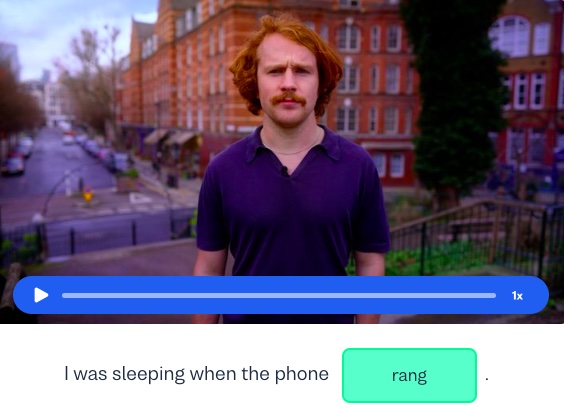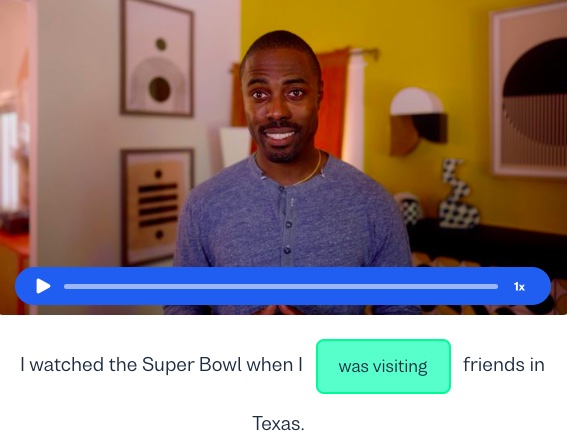Learn How to Use Definite Articles with Examples
We’ve put together plenty of examples and tips to help you understand how and when to use the English definite article ‘the’.
I want to learn...
Did you know that the most common word in the English language is the definite article “the”? Don’t believe it?
Read the first sentence again and you will see “the” is used four times, and all of them are necessary. This little word appears frequently in English but it still has some nuances that can confuse even the most experienced language learners. For instance, when do we use “the” opposed to “a” or “an”? When do we leave it out altogether? Where does it go in a sentence? Why do we say “the United Kingdom” but not “the Great Britain”?
In this article we will answer all these tricky questions and more so you will know everything there is to know about the definite article “the”.
Become a master in using English definite articles!
Soon you will be an expert in using definite articles in English and learn that in the sentence "I was sleeping when the phone rang," the word "the" functions as a definite article before "phone." It indicates that the speaker is referring to a specific phone. Continue learning with Busuu’s free online lessons!
What is a definite article?
Let’s start from the beginning. English only has one definite article – “the” – and it’s used with both singular and plural nouns. Like “a” and “an” it determines nouns and can add a little nuance to conversations. Take a look at these two sentences:
- I love to watch dogs playing.
- I love to watch the dogs playing.
In the first case you are a dog-loving person that loves to be in a park where dogs are playing and having fun, or watching funny dog videos online. In the second case you are someone that enjoys watching a specific group of dogs while they are playing. It could be your dogs, dogs at a shelter or your friends dogs. It doesn’t really matter because it would be obvious from the context. But the word “the” conveys the difference in meaning from any dogs, to a specific group of dogs.
When do we use the instead of a/an?
There are two types of articles in English. We know “the” is the only definite article, but there are also two indefinite articles, “a” and “an”. So when do we use one instead of the other? Let’s look at a few examples to help us understand.
- I saw a cat in the garden. The cat was black.
- Sarah and I went to an Indian restaurant yesterday. The food was very good.
- I need to speak to an accountant. Possibly the one that I spoke with on Friday, I think his name was Jeff.
In these three sentences we have an example of something that is generic or unknown and then something that is specific and known.
In first example there was a non-specific cat wandering in the garden, but in the second sentence, I am speaking about “the” cat that I just saw and it was black.
Similarly in the second sentence, we ate at a generic Indian restaurant but “the” food was very good. Obviously I mean the food that we ate at the restaurant, that specific food.
The same rule applies for the third example. Imagine I enter a busy office with dozens of people working and I need the help of an accountant. At first I don’t single anyone out, any accountant will do. But then, I remember that I spoke with someone named Jeff last Friday and he was very competent and nice, so I want him, that specific person.
In a nutshell, "the" is used when we are talking about a specific item already known or mentioned, while "a" or "an" is used when we are referring to any one of a general category. This is the difference between definite and indefinite articles.
Definite articles vs. indefinite articles
| Definite article (the) | Indefinite article (a, an) |
|---|---|
| refers to a specific noun I need the book that I was reading yesterday. |
refers to a generic noun I need a book. |
| refers to something known to both speaker and listener Let’s go to the park. |
refers to something unknown I drove by a beautiful park yesterday. |
If you need more information on “a” and “an”, you can read all about indefinite articles here.
Further definite articles examples
Definite articles are also used to refer to something unique, something that can’t possibly be referring to anything else.
- Look how bright the moon is tonight.
- It’s an island in the Pacific Ocean.
- We went to see the Statue of Liberty.
- The British Prime Minister gave a long speech today.
No chances of confusing one of these things with something else!
The definite article is always used with superlatives:
-
I saw a great show yesterday.
-
This is the greatest show I have ever seen.
-
Ann is a kind person.
-
Ann is the kindest person I’ve ever met.
Tip: Basically, every word ending in -est takes the definite article “the”.
Master using definite articles in your daily conversations!
In the phrase "I watched the Super Bowl…”, the word "the" functions as a definite article before "Super Bowl", a major sporting event in the USA. Learn more definite articles (and other sports events that Americans love) via Busuu’s free online courses!
Do we use the definite article in the plural?
Yes, we do use the definite article with plurals. Although you should remember that the same rule about specificity also applies in the plural. Let’s start with a few different examples.
- Did you feed the cat?
- Did you feed the cats?
- The cats in your apartment are so cute!
- Cats are always cute.
If you are a cat owner and you ask your roommate if he fed your cat or cats, it doesn’t really matter how many cats you have, you will use the article “the”. The same goes if someone wants to comment on how cute the cats are - the specific cats - that live in your apartment. But if a cat lover wants to express love for all the cats in the world, without referring to any specific cat, then we don’t use the definite article. Which brings us to the next point.
When not to use the definite article?
We don’t use the definite article with proper nouns. Nouns are those words that describe something, whether it is something concrete like a table, a chair, a sweater or something abstract like happiness, idea, motivation. Proper nouns are a type of noun that refers to a specific thing or person. So nurse and doctor are generic nouns, Sarah and Joe are proper nouns. Likewise, country and factory are generic nouns; Ireland and Coca-Cola are proper nouns. A simple way to recognize them is the fact that proper nouns are written with a capital letter.
In general, we don’t use “the” with proper nouns, but there are a few exceptions. Let’s look at the table:
Rules and common exceptions for the definite article
| We don’t use “the” with… | But we do use it… |
|---|---|
| country names I went to South Africa. I visited India. He’s from Great Britain. |
when it’s plural or if the name has the words kingdom, republic, confederation. I live in the Philippines. I never went to the United States. He’s the president of the Republic of Ireland. The Swiss Confederation. |
| street names, towns, stations, regions Hollywood Boulevard 5th street New York Grand Central Station Yorkshire |
with rivers, oceans, bridges, buildings The Thames The Atlantic Ocean The Verrazzano Bridge The Empire State |
| days, months, years, festivities I’ll see you on Tuesday. January is so cold. 2020 was a bad year. I celebrate Ramadan. |
with decades, centuries or periods I am a kid of the ‘90s. The beginning of the 21st century. The Middle Ages. |
| people’s names or family names Here comes Obama. She is Sarah O’Connor. |
in the plural when it refers to the whole family The Obamas. The O’Connors. |
Possessive pronouns and the definite article examples
The definite article never goes after a possessive (such as "my", "your", "his", "her", "its", and "their"):
- I like the green sweater.
- This is my green sweater.
- Sally lives in the house at the end of the road.
- This is Sally’s house.
As we can see, the definite article “the” is used as normal in front of common nouns like sweater or house but it disappears when there is a possessive involved like my, and Sally’s).
Where do articles go in a sentence?
You might be familiar with the main character of a well known fairytale, Little Red Riding Hood. Do you know which animal wants to eat Little Red Riding Hood? It’s a wolf. It isn’t just any wolf, but a wolf that is big and bad. How do you think these words are ordered? You should stay clear of the big bad wolf.
These words need to go exactly in this sequence because English has very strict rules on word order. The article “the” refers to the noun wolf and it always needs to be the first word on this cluster. Adjectives (big, bad) need to go before the noun (wolf) and the adjective for size (big) is always before a quality (bad). Any other word order would be incorrect.
Wrapping up: Definite articles in English
In this article, we’ve learned that the definite article can be used both in the singular and in the plural and that it is always used to identify something specific, unique or something that is known by speaker and listener. There are several proper nouns that don’t need an article but there are also several exceptions. And finally, we have seen that articles have a specific place in a sentence.
You now know all you need to know about the definite article. Ready to put into practice what you’ve learnt? Check out Busuu’s English language course and enhance your language skills with engaging exercises and personalized quizzes.
Ready to practice?
Busuu has hundreds of interactive fun lessons to help you understand and retain grammar rules. Download Busuu’s app today and join a community of millions of language learners.

